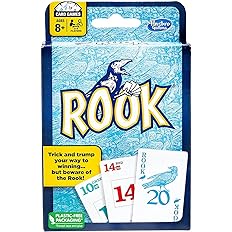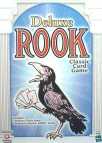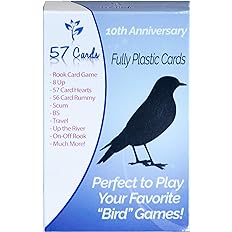Rook
- Introduction
- Kentucky Rook
- Call Partner Rook
- Rook with standard cards
- Other games with Rook cards
- Other Rook web sites
- Rook software and online games
Introduction
Rook is the name of a group of games and of the special deck of cards for the game which was introduced by Parker Brothers in 1906. The games are popular in Eastern Kentucky, in the Mennonite communities of Southern Ontario (near Elmira / Waterloo), Manitoba, Pennsylvania and Ohio, and probably also in other parts of North America.
The Rook deck contains 57 cards. There are four suits coloured black, red, green and yellow. In each suit the cards are numbered from 1 to 14. The 57th card is the rook card, which carries a picture of the bird. Rook cards are made by Parker Brothers / Hasbro and by Winning moves and Rook or Deluxe Rook cards can be ordered from amazon.com. Alternatively, Rook can be played with a deck of '57 Cards', which have similar cards in four colours, but the 57th card shows a flower rather than a bird. '57 Cards' are available from amazon.com as a high quality 100% plastic deck.
It is likely that Rook cards were at first introduced for the benefit of members of fundamentalist protestant religions, such as the Mennonites, who considered (and in some cases still consider) playing cards to be the "devil's tool". They were forbidden to play cards; but Parker Brothers filled the void with a game that was played like cards but did not use the standard playing card deck. There are people who refuse to play any cards with a standard deck but who will happily play Rook all night every weekend. There is a close parallel here with Kvitlech cards, which were playing cards bearing numbers, made for use by Central European Jews who were also forbidden by their religion to use standard cards.
The deck normally comes with a booklet describing a number games which can be played with the cards. The main group of games are point trick games with trumps and bidding. The cards in each suit rank from 14 (high) to 1 (low) and the counting cards are generally the 14 and 10 of each suit (worth 10 points each) and the 5 (worth 5 points). The Rook card, when used, is worth 20, and is generally an extra trump. In some games the 1 is promoted to rank above the 14 and is worth 15 points.
On this web page, I describe two Rook games, Kentucky Rook and Call Partner Rook, neither of which is exactly like any of the games described in the book provided with the cards. There are many other local variations, some of which will be added in future.
Kentucky Rook
This description is based on a contribution from John Hay, who says that this form of Rook is extremely popular in Eastern Kentucky, almost to the exclusion of other card games.
This game is for four players in fixed partnerships, partners sitting opposite. All the twos, threes and fours are removed from the deck, leaving 45 cards including the Rook card. Ones are high in each color, so that the card ranking is 1-14-13-12-11-10-9-8-7-6-5. The Rook card counts as the highest card of whatever color is trumps, ranking above the one. The card values are:
| Each 1 | . . . . . . . . | 15 points |
|---|---|---|
| Each 14 | . . . . . . . . | 10 points |
| Each 10 | . . . . . . . . | 10 points |
| Each 5 | . . . . . . . . | 5 points |
| The Rook | . . . . . . . . | 20 points |
so that a total of 180 points are available in each deal.
Ten cards are dealt to each person, one at a time, and five cards are placed face down in the middle of the table to form the nest - the dealer adds one card to the nest after each of the first five rounds of the deal.
The players then bid to decide who will have a chance to choose trumps. Each bid is a number; the minimum bid is 100, and higher bids must be multiples of 5. The player to the left of the dealer has the first chance to bid and the turn to speak passes clockwise around the table. At your turn, you can either bid or pass. Each bid must be higher than the last, and a player who has passed cannot bid again in that hand. The bidding continues as many times around the table as necessary until three players have passed. The fourth player is the high bidder, and the high bidder's team tries to take at least the number of points mentioned in the final bid. If on the first round of bidding the first three players pass, then the dealer is forced bid 100.
The bidder must then pick up the nest cards, without showing them to the other players, to make a hand of 15 cards, and then discard five of these cards face-down to form a new nest. The bidder is not allowed to put point cards into the nest. Picking up the nest can sometimes make the your hand worse: you may acquire several weak point cards which you have to retain, discarding in their place cards that you would have liked to keep. Having discarded, the bidder chooses trumps by naming a color.
The player to the left of the high bidder leads any card to the first trick. The other players in turn must play a card of the same color if they can. If they have no card of the led color, they may play any card. The Rook card counts as a card of the trump color. When everyone has played a card, the trick is won by the player of the highest trump, or, if no trump was played, by the highest card of the color that was led. The winner of a trick leads to the next.
At the end of the play, each team counts the total value of the cards they have won in tricks. If the tricks won by bidder's team contain at least as many points as the bid, that team score the amount of card points they took. If the bidder's team take fewer card points than the bid, they score nothing for the cards they won; instead they subtract the amount of the bid from their previous score. The non-bidding team always score the total number of points taken by their team, whether the bid was successful or not.
The game ends when a team reaches 500 points or more. The team which then has the higher score is the winner.
Variations of Kentucky Rook
Some people play with the Rook as the lowest card of the trump color rather than the highest.
Some people allow the bidder to discard point cards. In that case any points in the nest belong to the team that wins the last trick.
The book supplied with decks of Rook cards gives "Official Rook Tournament Rules" for a game called Kentucky Discard, which differs from the above game as follows:
- The ones are omitted from the deck, leaving 41 cards. Thus the highest card in each suit (except trumps) is the 14, and the total value of the cards in the deck is only 120 points.
- Nine cards are dealt to each player, and five to the nest.
- The dealer bids first, and the minimum bid is 70.
- Count cards may be discarded, and score for the winners of the last trick.
- The Rook card is the highest trump. It can be played to any trick, regardless of whether you could have followed suit to the led color. It must be played if a trump is led and you have no other trumps. If the Rook card is led, the other players must play trumps if they can.
- When a team reaches 300 points, the team with the higher total wins.
Call Partner
This description is based on a message from Brent Nelson.
Call Partner is a Rook game for four players. All 57 cards are used, and the 1 is high in each color, so that the ranking order is 1-14-13-12-11-10-9-8-7-6-5-4-3-2. In the trump color the Rook card ranks between the 11 and the 10. The card values are:
| Each 1 | . . . . . . . . | 15 points |
|---|---|---|
| Each 14 | . . . . . . . . | 10 points |
| Each 10 | . . . . . . . . | 10 points |
| Each 5 | . . . . . . . . | 5 points |
| The Rook | . . . . . . . . | 20 points |
| Last trick | . . . . . . . . | 20 points |
So the total value of the cards in the deck is 180 points, which, together with the 20 points for winning the last trick, makes a total of 200 points at stake on each hand.
The dealer deals out the cards one at a time to the players, so that each player has 13. The first card is dealt to the player to the dealer's left; after each of the first five rounds of the deal, a card is placed face down in the center of the table. These five cards form the nest.
The players then bid to decide who will have a chance to choose trumps. Each bid is a positive number, which must be a multiple of 5. The dealer has the first chance to bid and the turn to speak passes clockwise around the table. At your turn, you can either bid or pass. Each bid must be higher than the last, and a player who has passed cannot bid again in that hand. The bidding continues as many times around the table as necessary until three players have passed. The fourth player is the high bidder, and the high bidder's team tries to take at least the number of points mentioned in the final bid.
The bidder then picks up the nest cards, without showing them to the other players, to make a hand of 18 cards, and then discards any five of these cards face-down to form a new nest. Having discarded, the bidder chooses trumps by naming a color, and also calls for a partner by naming a card. Whoever has the called card becomes the partner of the bidder. Those two players play together as a team for that hand only, and the other two players form a team playing against them. [The holder of the called card should not reveal who they are - their identity will become apparent when the called card is eventually played to a trick. If the bidder holds the called card, the bidder plays alone and the other three players form a team.]
The player to the left of the high bidder leads any card to the first trick. The other players in turn must play a card of the same color if they can. If they have no card of the led color, they may play any card. The Rook card counts as a card of the trump color. When everyone has played a card, the trick is won by the player of the highest trump, or, if no trump was played, by the highest card of the color that was led. The winner of a trick leads to the next. The winner of the last trick takes the cards which the bidder discarded into the nest.
At the end of the play, each team counts the total value of the cards they have won in tricks. Since the scores are accumulated from deal to deal but the partnerships can change for each deal, it is necessary to keep a separate score for each player. If the bidder's team took at least as many points as the bid, then each member of the bidding team scores the total amount of card points won by the team. If the bidder's team take fewer card points than the bid, they do not score anything for the cards they won; instead they subtract the amount of the bid from their previous score. The members of the non-bidding team always score the total number of points taken by their team, whether the bid was successful or not.
The game ends when a player or players reach 500 points or more. The player who then has the highest score is the winner.
Rook with standard cards
Some Rook games have been adapted for play with a standard deck of 52 cards plus joker. Peter Dutton's Rook page (archive copy) described one such version which is played in Princeton. The ace corresponds to the 1 and is worth 15 points; the king (10 points) is second. In this game the joker stands for the rook and is the lowest trump.
Other games with Rook cards
The reverse has also happened, in that many games originally played with the standard deck have been adapted for Rook cards. For example, Golden Ten is a simple version of Hearts played with a Rook deck, and Toonerville Rook is a version of Contract Rummy played with several Rook decks.
Other Rook web sites and software
Coit Morrison's Rook Card Collection site displays his collection of Rook sets and related items from 1910 to the present and includes a forum.
Here is an archive copy of Peter Dutton's Rook page, which had a useful collection of information about Rook, including where to obtain cards and Rook software.
Rook software and online games
Mystic Island includes an online version of Rook under the name Parrot, and offers tournaments, some of which are in Duplicate format. Several play variations are available including a cutthroat format and the ability to play with or without the 1's.


